At 4,842 metres, mount Pachatusan is far from the highest mountain in the Peruvian Andes, but on this day it is a formidable mountain; too formidable for we three hikers to pass.
This post was originally published in 2014. It has since been updated for accuracy of links and content.
The Pachatusan Trek (aka “The Plan”)
With gear and provisions for a two-day trek, we take a taxi from Cusco to the next town called Huasao (pronounced Wah-sah-oh) to begin our hike. From there, we (plan to) head up, up, and up some more to a campsite just shy of the summit of Pachatusan. On day two we (plan to) skirt around the summit and down into the next valley (the Sacred Valley), and grab a short ride back to our home in Pisac.
My companions for this informal trek are my friends Silvia, and Miguel (with whom I’ve hiked to Machu Picchu, Lares Hot Springs, and Kinsa Cocha).
The Significance of Pachatusan
The name Pachatusan means “one that sustains the Earth” in the Quechua language. This commanding mountain is one of many that is spiritually revered by the local people. When I first came to Peru in March of 2014, my room looked out on this mesmerizing mountain that I hoped to grace the higher ridges of at some point.
However in the mountains, anything can happen, and on this day it appears that Pachatusan has something else in store for us.
The Climb

With sunshine and warm weather, we hit the trail with high spirits and energy. The views over the Cusco valley are beautiful and we are (almost) on top of the world.

As we climb higher, we encounter flocks of sheep grazing the grass which is brown, being the tail end of the dry season (aka winter) in Peru. I wonder where these sheep live; surely people don’t live this high up and remotely in the Andes….do they?
Plans are Meant to Change
As we continue upwards to the top of the valley, clouds start rolling in above us. We are so high, and the clouds are so close, I feel I can simply reach up and touch them. The clouds are dark, but I’m not scared. Rather, I’m fascinated with these clouds.
Then the clouds rumble with thunder.
“Wow! This is what it’s like to see a thunderstorm brewing, up close and personal,” I muse with more curiosity than fear.
Lightning streaks across the sky, then hits the next ridge, very close to us.
As fascinating as the lightning is, with this I click into survival mode. I look up at my makeshift trekking pole, a eucalyptus branch that stands a few feet higher than I am. I drop this tempting lightning rod. Then I look around and realize we three hikers are the highest points on this ridge of brown scrub and small bushes, and the storm is rolling over us.
Understanding that our chances of being struck by lightning are now somewhat higher than normal, we quicken our pace to reach the next ridge where we can assess the situation.
Then, the hail starts.
It begins as large drops of rain, coming on slowly enough for us to put our rain gear on. Then the temperature drops dramatically, the wind picks up, and we are deluged with hail. We quicken our pace even more, if for nothing else but to keep warm as our hands are starting to turn purple from the exposure. There’s no time to dig around in our bags for gloves; we just keep moving, ever-hopeful that this storm will pass.
It doesn’t.
Panting and exhausted from our upward high-altitude jog through the hail, with fascinating (and now scary) bolts of lightning around us accented with loud cracks of thunder, we take the best cover we can find: a tiny bush standing about four feet high.
As the hail continues to blow sideways, we laugh at what a sight we must be, sitting under a bush that is doing almost nothing to keep us dry, eating our wet sandwiches to get some energy to keep our bodies warm.
“This bush really isn’t cutting it,” I say, stating the obvious.
“Just over that ridge,” Miguel says pointing to a spot about 20 minutes away, “is a house. I think we can make it.”
“Does somebody live there?” asked Silvia.
“Does it matter?” I say. “It’s shelter! Let’s go!”
And with that, we gather our soaking wet selves and gear and make a dash for the next ridge.
15 minutes later, Miguel turns to us and shouts above the din of the thunder and hail. “I have good news and bad news. The good news is there’s a house right over here.”
“And the bad news?” I say, expecting him to say there isn’t anybody home with a fire going and a hot meal ready.
“There’s no roof.”
Considering how high and remote we are, I’m not surprised that all that exists up here are the ruins of old homes, and yet I can’t disguise my disappointment.
“Don’t worry,” says Miguel with a wry smile at his little joke. “There really is a house – with a roof – a few minutes from here. I’ve passed by it before.”
Sure enough, as we continue our mad dash, a few structures come into sight that give us a final burst of energy to push on.
The Quechua Community
We finally stumble on a deserted cluster of about six structures spread over a quarter kilometre of land. It’s hard to tell if they’re lived in or abandoned; they look old and less than “up to building code”. But with a roof and walls and yet more thunderous hail coming down on us, we aren’t in a position to be picky.
We check out the first structure, which bars us access with a small padlock that appears to not only be holding the slanted wooden door shut, but also holding it upright. The next structure has two locks. The third – another lock. We are losing hope that there is any viable shelter for us up here.
Finally we find a wee house with an open door. We burst in and collapse on the dirt floor, wet, shivering, and tired.
The Quechua Home
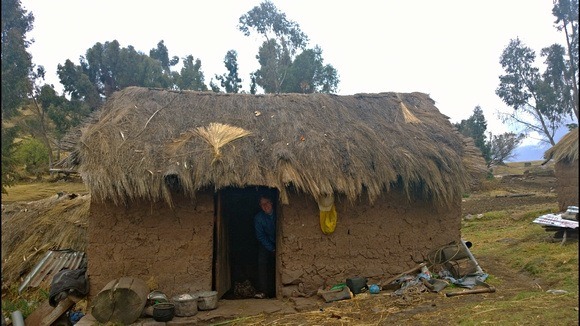
There is no power in what appears to be this abandoned Quechua home, and with no windows it’s very dark inside. But with time as our eyes adjust to the darkness, we see more and more, realizing we are sitting in a proper Quechua home.
Although still cold, we are fascinated with our surroundings as we stamp our feet and clap our hands to warm up and dry off.
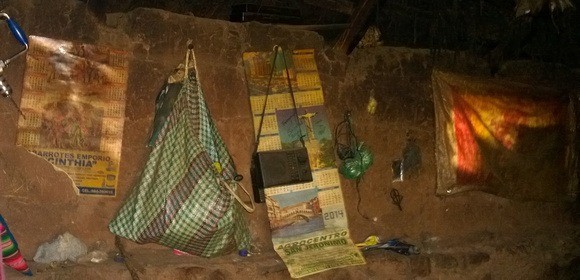

At least a dozen cuy (guinea pigs) are running around in the corner recesses (hint: they’re not pets – they’re food). We spy a toy truck and some blankets typically used by Quechua women to carry loads (and children) on their backs; a family must live here.
We see the bed – barely big enough for two people, the mattress made of lumpy llama skins covered with blankets of local weavings and woven alpaca.

Two tiny kittens are huddling together in the “kitchen” beside a half-burnt piece of wood. What you see here is the whole kitchen, which is fuelled by a small fire underneath, protected by homemade red clay bricks.
We realize we’ve broken into somebody’s home (even though the door was unlocked), and we feel conflicted about being here, yet curiously voyeuristic. We are careful not to touch anything, and simply grateful for the chance to get out of the continuous hail, dry off a bit, and put some extra layers of clothing on.
We wonder where the home owners are. Will they come home tonight? Or is this a second home to a Quechua family that lives in the “proper” community over the next ridge 30 minutes away?
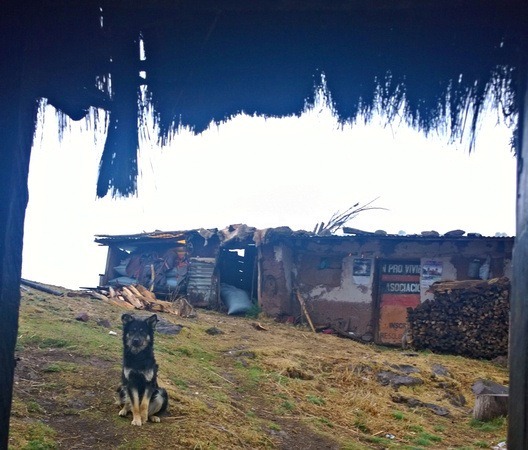
We hear lambs mewing. Looking out the door, we see a storage shed, inside of which are two wee lambs, guarded by the property dogs. With all these animals (guinea pigs, kittens, dogs, and lambs), we are quite sure that people live here, but we’re still confused about why the place is so deserted and where everybody could be in this storm. We hope that they, too, have shelter right now.
The hail has subsided, but we are still very cold and trying to dry off. Silvia is unwell and needs rest; we wrap her in our blankets and she timidly curls up on a corner of the bed, while Miguel and I go outside to assess the plan.

Dramatic sky or not, we are struck by the sheer beauty of this place. It is so simple, rustic, yet complete. I feel some degree of envy for these people, who live such a basic life using fire for warmth and light, animal skins and weavings for blankets and clothes, and tend to the fields of potatoes and herds of sheep and cattle for food.
They don’t watch Breaking Bad, they don’t concern themselves with the Dow Jones Index, and they probably don’t even know what an iPhone is. And yet, the very last thing I feel, is sorry for them.
“The place where we are supposed to camp is an hour away,” says Miguel. We look at each other, and look at the sky in the direction we’re supposed to hike, which is very obviously (and imminently) bringing more weather.
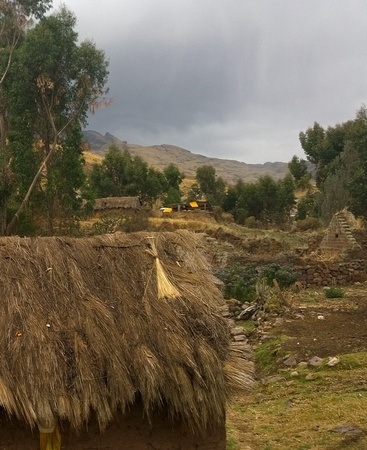
“Maybe it’s time for a plan B,” I say. “Do you suppose the people who live here could put us up for the night – if they even come home at all?” I look at the number of structures in this little cluster of houses and surmise that surely there is space for us somewhere.
“Yes, it’s possible, but if and when they come home it would be polite to have tents set up somewhere, so we don’t appear intrusive.”
And with that, we head back to the Quechua home where Silvia is huddled up and announce our plan to set up camp. She is relieved that we’re not going to push for our original campsite, having said she’d rather walk an extra hour tomorrow than be (even more) wet and cold the rest of today.
We are so grateful to the unknown owner of this home for the shelter and warmth that they unwittingly gave us, that we leave them some presents: paulo santo (dried wood) and other wood we have collected for a fire, mapacho (jungle tobacco cigarettes), coca leaves, some cheese and nuts, and even a hat.
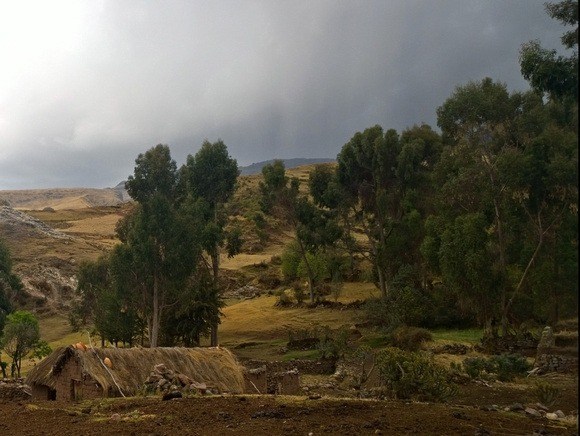
We gather our belongings and head back outside to search for a place to set up our tent. But we don’t get far; the sky immediately blackens, the temperature drops yet again, and once again we are deluged with yet more hail. Within minutes we are back in our Quechua dream-house, laughing at the message Pachatusan seems to be giving us.
An hour later the second storm has passed, and we’ve long missed our window of opportunity to make it to our original campsite. Darkness is soon to set in, and we wonder where on earth the owners of these homes could be.
Miguel and I head outside again while Silvia continues to rest.
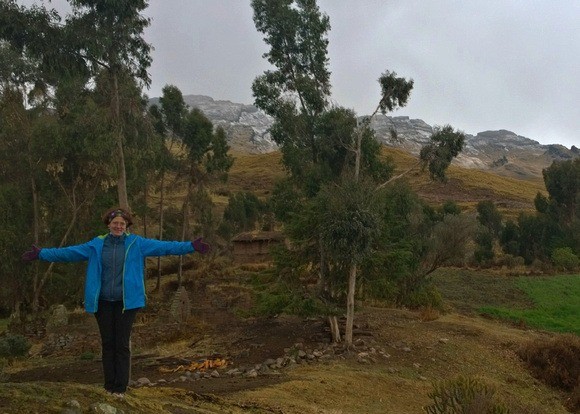
“It’s almost dark. Could there really still be a bunch of families coming back here for the night?” I ask Miguel.
“I don’t know.”
I’m of two minds about the situation; on one hand I’d love to meet the people who live here, and I have visions of them opening their homes to us for the night as we share food, culture, fire, and a few laughs. On the other hand, I’m aware of the cramped space with only three of us in the hut, and would kind of selfishly like to have the place to ourselves for the night.
Miguel echoes my thoughts, finishing with “but it would be nice to meet the owner of this home.”
With that, we get what we wish for when we see a lone man on a horse coming down the hill towards us.
Miguel converses with the man in a combination of Spanish and Quechua languages. He learns that the homeowner’s name is also Miguel, and that he has a son who lives with his family in the other house in his cluster of three dwellings (the third dwelling being a shed). We ask if there is a place to put us up for the night, slightly exaggerating Silvia’s state of ill health, while apologizing for basically breaking into his home this afternoon. He seems a bit surprised to see this strange gang of hikers having taken over his home, but he nods and comments that the storms today were unbearable. (He seems dry himself; he must have taken shelter somewhere).
Miguel (the home owner) apologizes, saying he doesn’t have space for us in his homes, nor does he have the key to the other locked homes which belong to somebody else (who won’t be returning tonight), but he shows us a basic shelter/roof of corrugated tin and plastic, with partial walls (the ruins of an old home?) to give us some refuge from the wind and weather, under which we can pitch our tent.
Grateful for this gesture, we use the last light of day to set up our tent and collect some wood for a fire.
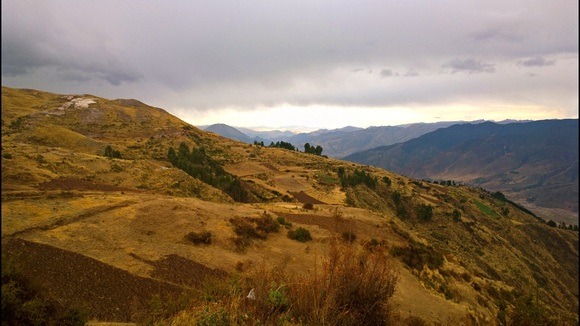
Although still cold, we are now mostly dry and we warm up by a fire for the night, singing songs and feeling very grateful for the day’s adventure of dramatic weather and the turn of events it brought on. Not many people get the chance to see a Quechua home up close and so personally, and we are happy to have a place to camp, even if we aren’t invited back in to Miguel’s home for the cramped hospitality we were secretly hoping for.
The Next Morning

The next morning we are serenaded by sunshine, but only somewhat rested, each of us having had a rock or lump under us that plagued us through the night. We eat breakfast while discussing our planned hike for the day.

But before we can even fully pack up our tent, we see another bank of dark clouds coming over the top of Pachatusan (which is still white from yesterday’s hail), and we are reminded of yesterday’s torrent. There are no more Quechua houses to take refuge in. If we continue on, we have at least six hours of hiking, and we are surely to get wet, if not hailed on again (or even struck by lightning). If we return the way we came, we have a three to four hour hike back down to Huasao, and an alpaca burger waiting for us at a restaurant in Cusco.
We choose the alpaca burgers.
Kicked off Pachatusan
The mountaineer in me doesn’t like turning back. It smacks of failure. My fear (and maybe a spot of laziness) got the better of me, it felt more appealing to just return the way we came; even if we got wet it would be a shorter walk, mostly downhill. Pachatusan showed us her power and wrath, and I strongly felt that she was telling us that today was not our day to stand on her highest ridges.
Miguel and Silvia are far from disappointed to be turning back; instead we all celebrate the amazing adventure we’ve had, saying in some ways it turned out even better than what our original plan would have been. At least we have a story to tell and a very unique experience under our belts.
When I was in Peru last time, I found success in the failure of summiting another mountain, and again, in this moment I can only smile and realize that some of life’s best laid plans are meant to change. The greatest gift we can give ourselves is the ability to adapt, and forgive ourselves for those things we simply cannot do.


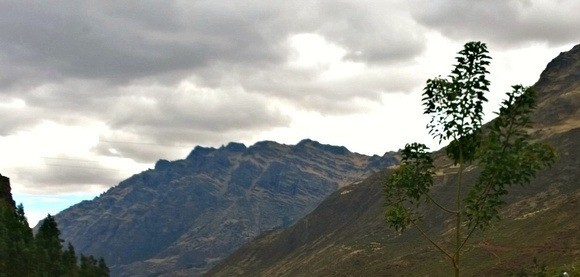

Great post Nora! I agree, even if the original plan fizzled out, you have a great story and memories instead!
Hey Emily,
Indeed! I feel so grateful for the experience, even though it wasn’t what we planned – at all! It was such a great adventure.
great read!!
Thanks, Jared!
A real life story Nora, a great story! Things change & plans change, the mountain will be there next time.
You got it, Rob! The mountain is great, but the unexpected experience and sneak peek into a Quechua home was priceless.
I love reading about your adventures, and how they are still fun even if they didn’t turn out as you expected. Thanks for sharing your stories.
Thank you, Eric! I’m glad you enjoyed reading about this tale of twists and turns.
That was an adventure!! I’m so jelly of you right now.
Glad you’re Ok, and that you’re enjoying Peru so much 😀
Cheers!
Thanks, Jorge! I love these kinds of adventures. 🙂
Great story. Inspired to try the hike. What a great experience! Both the house and the idea of being so close to the clouds. Pretty jealous
Hi Rebecca,
There are plenty of places to hike in the area that are just like this! It’s amazing. 🙂
Loved your description of your hike, intention and Plan B. I’ll be there in June 2019 – how difficult is the hike at that altitude? For a June time period, should I expect cold up high? Thanks for the blog entries, I’ve found them insightful.
Hi Judy,
The altitude affects everybody differently. I was lucky in that it rarely affected me. But even without hiking, Cusco and the Sacred Valley can induce altitude sickness. I recommend planning nothing for your first few days in the region, so your body can acclimate if it needs to. Also, coca tea (just hot water and coca leaves) works wonders.
As to the weather, year round, it gets cold at night and warms up during the day. June is the start of winter time (dry season), so at least it won’t as likely rain, but it can get below zero at night at very high altitudes (such as the peak of Pachatusan), so if you’re planning on doing any multi-day treks, come with lots of layers!